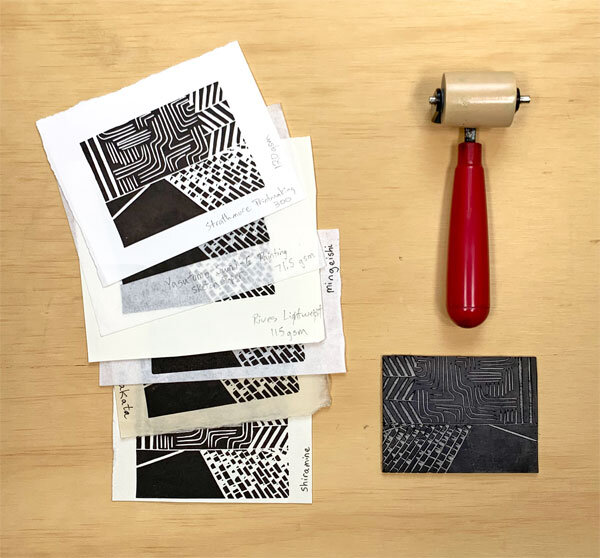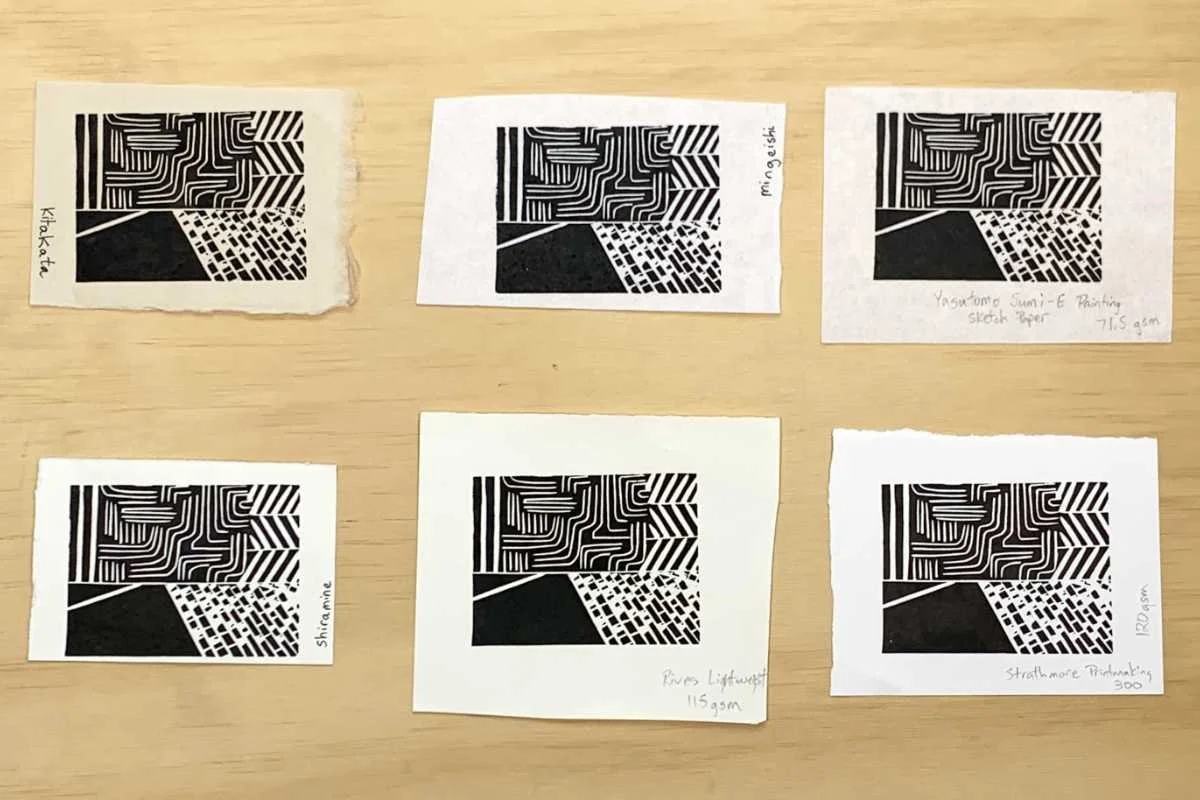Choosing Good Papers for Hand Printing Linoleum Blocks
I’ve wanted to do a test of papers for hand printing linocuts for a long time and I took it on this year. Though I almost exclusively print with a press, I know most readers and students print by hand, which presents its own challenges. When I help people troubleshoot their printing problems, the choice of paper is sometimes a factor.
There are some specific paper recommendations at the end of this post and I’ve included Blick and Amazon links because they're easy places to order paper. It can be hard to find good printmaking paper at a local art shop. Blick, in particular, has some helpful customer reviews to read if you want other opinions. If you click on their links and choose to buy something, I get a small commission (at no extra cost to you) since I participate in their affiliate programs. You can find more details about this here. But, if you have a favorite neighborhood art supply store, go there by all means or try McClain’s Printmaking Supplies in the US.
Testing papers for hand printing linoleum blocks
What to Consider When Choosing a Paper for Hand Printing
If you were to ask me what block printing ink I think is the best, I would give you a couple suggestions and feel pretty confident that it will work for you. Paper is a little different, though. There are so many different types of paper to choose from and what you have available will partially depend on where you live. So, I don’t think there is necessarily a perfect paper for hand printing. But I’m going to give you suggestions on what to look for in paper to help guide you. I’ll also provide some specific recommendations.
A Paper’s GSM
Choosing a paper of the right weight is really helpful for printing linocuts, woodcuts or rubber blocks by hand. When you shop you’re going to notice a term on the package or product listing called, “GSM.” This stands for grams per square meter and is a measure of a paper’s weight. The higher the GSM the heavier the paper.
Importantly, if you’re printing by hand instead of a press, you’ll probably want a light to light-medium weight paper. Say, between 30-120 gsm, though this is not a hard and fast rule. You’ll want to avoid really thick paper like Stonehenge (250 gsm) or Rives BFK (250 gsm) when printing by hand, in my opinion. I would say, though, that those two papers are probably my favorites when printing on a press.
To give you a frame of reference for paper weight, I grabbed my pack of inkjet printer paper and it says it’s 75 gsm.
Paper Acidity
A final print you care about should be printed on acid free paper that will ensure it will last a lifetime, give or take. Here’s a good glossary that defines technical paper terms like acid free, neutral pH and sizing.
Paper Color
I’m reviewing neutral color papers than range from white to tan. Some papers are not nearly as truly white as others!
Paper Size
Paper comes in all sorts of sizes and is sold by the sheet or in a pad. Make sure the paper is a good size for your prints to reduce the amount of wastage. Some paper is of such odd sizes I just don’t feel like it’s much use to me.
Paper Texture
Some paper is extremely smooth, while other paper has a more rough handmade feel.
Very generally speaking, lighter / smoother paper will produce more consistently crisp prints with less effort by hand than heavier / rougher paper.
Papers for Lino Printing by Hand
I used a small abstract linoleum block for testing a selection of the most promising papers. All the papers were printed dry. The linoleum block printing supplies I used for the test were:
Caligo Safe Wash Relief Black Ink - (read review)
The back of a metal spoon and/or a Speedball baren to burnish the print
The following are papers that I tried in my studio and found to be worth experimenting more with when hand printing linocuts. I’ve listed them from lightest to heaviest paper.
Six of the printmaking papers I tested for block printing
The lightest papers will be easiest to print consistently by hand. But, you have to be a little more careful with them because they’re thinner. They crease easier, frustratingly, and if you’re too rough when burnishing your prints little bits of the paper can slough off the back.
Kitakata (30 gsm) - a delicate tan paper that comes in 16” x 20” sheets. Beautiful, neutral pH paper that’s competitively priced but thinner than I usually use.
Awagami Mingeishi (45 gsm) - comes in three different colors and in larger sizes than many other attractive options. The paper is a little more see-through than the thicker papers like Rives Lightweight.
Yasutomo Sumi-E Painting Sketch Paper (71.5 gsm) - this is an inexpensive white paper that prints well and comes in pads. I’ve used this on rare occasions over several years. Good for proofing blocks.
Awagami Shiramine (110 gsm) - a new paper for me and I really liked it. It’s off-white. A little on the thicker side, but still produced a nice crisp impression.
Rives Lightweight (115 gsm) - is sold per sheet and comes in medium and large sizes. An excellent, all-around high quality paper. It takes a fair amount of pressure to get a solid print. Keep in mind that even though there are a couple neutral cream-ish colors, none are truly white, in my opinion. Also, this is not to be confused with the 175 gsm option. I’ve printed successfully with this paper on an etching press.
Strathmore Printmaking 300 (120 gsm) - one thing that’s nice about this paper is it’s relatively easy to find in art stores and online. It comes in pads of a range of sizes so it’s ready to use when you buy it. The downside is that it’s about as thick a paper as I would recommend for hand printing. It’s on the upper threshold for weight. It will produce very nice prints if you burnish the print with enough force.
So, there we go, a roundup of some good paper options for hand printing linocuts. They each have pros and cons so one printmaker might find one paper type better than a different person, so please keep that in mind. It’s worth trying a range of papers to see what fits your printing practice and studio / home conditions.
Have fun printing and feel free to contact me with any questions!


